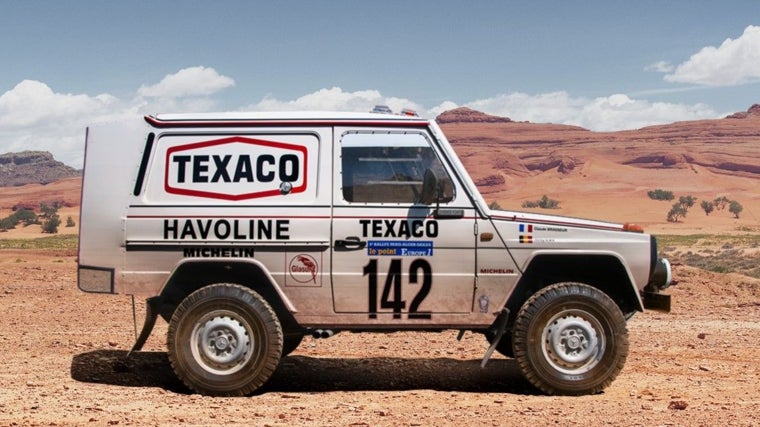Jacky Ickx, born Jacques Bernard Ickx in Brussels on January 1, 1945, is a living racing legend. No, don’t look for the Belgian on the list of World Drivers’ Champions. Maybe he doesn’t need that title. Rather, it would be the World Cup that would need his name.
He began his motorsport career in 1964. In 1967, he was European Formula 2 champion and debuted in Formula 1. He won 8 F1 grands prix during his career: France in 1968, Germany and Canada in 1969, Austria, Canada. and Mexico in 1970, the Netherlands in 1971 and, finally, Germany in 1972. He left Formula 1 in 1979, after having won two runners-up world championships, in 1969 and 1970.
With Ferrari, in the 1970 British GP
His endurance record is even more impressive. Two world championship titles, in 1982 and 1983, or six victories in the 24 Hours of Le Mans, the main event of the discipline (1969, 1975, 1976, 1977, 1981 and 1982), are a synthesis of a fantastic resume of the that some chapters will be written in the desert sand…
The call of adventure
It is January 1, 1983. While in Paris the champagne is flowing and the music is playing to celebrate the New Year, in the Place de la Concorde the gasoline is flowing and the engines of 253 cars and trucks, and 132 motorcycles, can be heard setting off. the fifth edition of the Paris-Dakar, an adventure dreamed of by Thierry Sabine, a young Frenchman who changed equestrian competitions for rallies, first by car and later, by motorcycle, by the raids that began to gain popularity at the end of the seventies.
In just five years, the Paris-Dakar, Sabine’s dream, has become an event that no longer only attracts adventurers with handcrafted cars, but also well-known drivers, along with professional trainers, even brands.
In this 1983 edition, the participants have to cross France, Algeria, Niger – where the hell of Ténéré awaits them in one of the most terrifying stages in the history of this test – Upper Volta, Ivory Coast, Mali, Mauritania and Senegal . Twelve thousand kilometers….

We are in 1981. Claude Brasseur and Jacky Ickx participate with a Citroën CX in their first Paris-Alger-Dakar
Among cars, the number 142 attracts many looks and comments. It is a Mercedes G-Class driving which is none other than Jacky Ickx, accompanied as co-pilot by Claude Brasseur (1936-2020). A famous actor who has filmed with directors of the caliber of Jean Renoir, Brasseur is passionate about sports: he has worked as a journalist for LÉquipe, he has been part of the French bobsleigh team, and he is passionate about motorsports. Both Ickx and Brasseur were well aware of the difficulties of the Paris-Dakar, a test in which they had participated with a Citroën CX as a team for the first time in 1981.
In search of more power
And in 1982, Ickx and Brasseur joined the Mercedes-Benz France project, whose managers decided to participate in the test with two 280 GE of the 460 series. Customer service director Gunter Latour has good contacts with Mercedes-Benz in Untertürkheim. The project is entrusted to Georg Berkmann, an engineer specialized in adapting passenger car engines to commercial vehicles. Precisely, at the engine level, Berkmann chose the standard version of the M 110 with 185 HP as a base. He wanted to get even more horses. The engineer resorted to camshafts originally planned for the power improvement of the 280 SL (R 107). In this way, the “Paris-Dakar” engine reached around 197 HP. In comparison, the M 110 of the Mercedes-Benz 280 GE launched in 1979 developed 156 HP.
But he has more concerns. The main problems when facing the deserts of the African continent are extreme temperatures and dust. In this sense, Berkmann moves the engine air inlet to the interior, where temperatures are usually lower and the dust content in the air is lower. Another problem is the poor quality of gasoline. And Berkmann opts for a simple but effective solution, as he said a few years ago: «I placed yellow and red marks on the ignition distributor. “So drivers could quickly adjust the ignition timing if the engine knocked due to poor fuel quality.” To make this quick and not have to search for the right tool, the engineer tied a four-millimeter Allen wrench to a chain near the ignition distributor. Jacky Ickx was also thorough. In preparation, he labeled each relay to quickly locate problems and faults.

In profile, you can see the elongated rear part of the 280 GE, to improve aerodynamics
With the upgraded engine, the 280 GE reached a top speed of 175 km/h, 25 km/h faster than the street version. However, after the experience of 1982, in which they had finished third (Jean-Pierre Jaussaud/Michel Brière) and fifth (Jacky Ickx/Claude Brasseur), Berkmann was sure that this pace would not be enough to win in 1983. For reasons of reliability, further increasing engine power was not an option contemplated. So Berkmann turned to engineer Rüdiger Faul, who had developed the aerodynamics of several racing cars and the record-breaking C 111-IV.
Drain pipes and aerodynamics
To optimize the aerodynamics of the 280 GE, Faul took a pragmatic approach. “In the construction department of the Sindelfingen plant I got some plastic wastewater pipes with a diameter of 70 millimeters,” he recalls. He fixed pieces of the tube around the windshield, thereby significantly optimizing the flow pattern in this area. Curiously, work has also been done on these pillars now, in 2024, in the new electric G-Class, to improve aerodynamics.
But let’s go back to our story. At the rear, Faul opted for striking extensions of the roof and rear side walls. In the company, this change in the body line received the ironic name of “the bus shelter.” The measures dramatically optimized air resistance. Measurements in the Untertürkheim wind tunnel showed that the CX, the penetration coefficient, was reduced from the original 0.52 to 0.41, i.e. an improvement of 20.5 percent. Georg Berkmann summarizes: “Thanks to the aerodynamic changes, the maximum speed increased by around 20 km/h, reaching almost 200 km/h, while the fuel consumption per 100 kilometers was reduced by five liters.”

Ickx, today a legend who has just turned 80, is still linked to motorsports
Ickx and Brasseur dominated the race from the beginning, but the broken bridge of the car almost ruined the victory. Thanks to the fact that he rode his teammate Jean-Pierre Jaussaud’s bike, he was able to continue the race. There was a claim against the winning team that ultimately did not prosper because Mercedes argued that the regulations did not contemplate the prohibition of exchanging parts between competitors. However, this situation greatly displeased Ickx, as he stated at the end of the test. The Belgian driver also pointed out, after his victory, that the Mercedes “was too heavy (around 2 tons) and in the future it will not be possible to win with this type of car.” In my opinion, the next editions will be reserved for true prototypes, lighter and better balanced. It is enough to see how the Dakar cars evolved to confirm the correctness of this prediction.
A change in the way of seeing life
Over the years, Ickx has also spoken about other changes related to the Dakar, but, in this case, on a personal level: “if I ask myself about the origin of my open-mindedness, and about my feeling of living, since then, the best part of my life, the Dakar is the extraordinary opportunity to have discovered and met people whose solidarity and humanity are essential for survival.
Africa, desert life where you can’t cheat. You can tell a lot of stories, but you quickly come back to reality. We are little, really. There, thousands of years ago, there were already people who lived like this. Breeding, culture, life, awareness of life. And awareness of the privileges we enjoy and that are not always linked to talent, only to luck or destiny.
Ickx would return to the Dakar, this time at the wheel of a Porsche. But that’s another story.
#ParisDakar #Ickx #Mercedes #GClass


